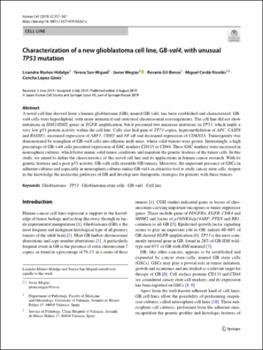Characterization of a new human giant cell glioblastoma cell line,GB-val4, with unusual TP53 mutation
Date
2019Abstract
A novel cell line derived from a human glioblastoma (GB), named GB-val4, has been established and characterized. GB-val4 cells were hyperdiploid, with many numerical and structural chromosomal rearrangements. The cell line did not show mutations in IDH1/IDH2 genes or EGFR amplification, but it presented two missense mutations in TP53, which imply a very low p53 protein activity within the cell line. Cells also had gain of TP73 copies, hypermethylation of APC, CASP8 and RASSF1, increased expression of ARF1, CDH1 and NF-κB and decreased expression of CDKN2A. Tumorigenity was demonstrated by transplant of GB-val4 cells into athymic nude mice, where solid tumors were grown. Interestingly, a high percentage of GB-val4 cells presented expression of GSC markers CD133 or CD44. These GSC markers were increased in neurosphere cultures, which better mimic solid tumor conditions and maintain the genetic features of the tumor cells. In this study, we aimed to define the characteristics of this novel cell line and its applications in human cancer research. With its genetic features and a poor p53 activity, GB-val4 cells resemble GB tumors. Moreover, the important presence of GSCs in adherent cultures and especially in neurosphere cultures makes GB-val4 an attractive tool to study cancer stem cells, deepen in the knowledge the molecular pathways of GB and develop new therapeutic strategies for patients with these tumors.





